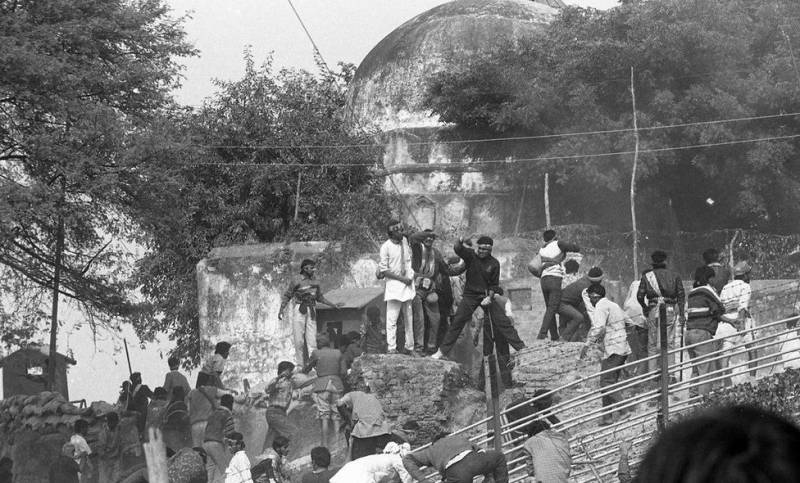Hindu mobs tore down Babri mosque in Ayodhya on 6 December 1992
Shares

Hindu mobs tore down the 16th Century Babri mosque in India's holy city of Ayodhya on 6 December 1992. The riots that followed killed nearly 2,000 people. A day before the incident, photographer Praveen Jain joined a group of Hindu volunteers to witness what they claimed was a "dress rehearsal" for the demolition. Here, he shares his pictures and tells his story of that day.
I arrived in Ayodhya on the foggy evening of 4 December 1992. Thousands of workers belonging to the Rashtriya Swayamsevak Sangh (RSS), an organisation dedicated to promoting Hindu nationalism, had already gathered. The RSS is the ideological fountainhead for Hindu groups, including the Bharatiya Janata Party (BJP) which now rules the country.
They planned to start the construction of a temple on the site that they believed was the birthplace of the Hindu god Ram. They had given a commitment not to touch the mosque and to restrict construction to a religious ceremony symbolising the laying of the first bricks.
A BJP MP I was in touch with told me there was going to be a rehearsal for the demolition of the Babri mosque on the morning of 5 December.
"I have orders from top bosses to ensure that no media is granted access to this exercise. But you are a friend and I am giving you this information," he told me.
Disguised as a volunteer - wearing a saffron scarf, headband and a special entry badge on my jacket - I was escorted to the meeting ground the size of a football field a few yards from the mosque. Thousands of workers wearing saffron headbands and scarves had gathered there. The area was cordoned off by badge-wearing volunteers.
"This is the only way you can take photographs of the rehearsal. Stay close to me and shout slogans like the volunteers, blend in. This way you will be safe," the functionary told me.
A burly man suddenly stood before me gesturing me to put away my camera. I pointed to my badge and loudly shouted slogans like everyone else. He nodded and directed me to a large group of men standing at a distance.
I whipped out my camera and started taking pictures of the incredible scene unfolding before me.
Men with crowbars, pickaxes, shovels and iron rods were trying to topple a huge mound of earth.
Everything was done with precision. These were not mere volunteers but professionals who knew how to bring down a building.
The Liberhan Commission (the government-appointed panel which tabled its report on the destruction of the Babri mosque in 2009) makes the following observation:
"It was averred before the Commission that a rehearsal was carried out for demolition of the disputed structure. Some photographs too were placed on record before the Commission. It will however not be safe to hazard finding about training in the absence of the conclusive evidence, though there is some circumstantial evidence and some statements do point finger to the conclusion that the Karsevaks were trained in demolition."
My photographs capture a man, the only one in the crowd of volunteers with his face covered by a handkerchief, barking orders at the men tugging away at the mound with ropes and iron wire meshes.
He appeared to be some sort of a leader of one of the right-wing parties and, therefore, didn't want to disclose his identity.
The mound was successfully toppled to loud cheers and lusty slogans from the volunteers.
I hid my camera inside my jacket and exited the place, chanted along with the crowd, thrilled that I was the only journalist to have witnessed this rehearsal and photographed it for posterity.
The next day, I along with other journalists took position on the fourth floor of a building overlooking the mosque and a raised platform where important leaders of the Vishwa Hindu Parishad (VHP) and BJP were overseeing a rally of at least 150,000 volunteers.
Even police guarding the site were shouting slogans. Just after noon, the crowd turned violent and charged at the policemen and volunteers guarding the mosque.
Some climbed to the fourth floor and attacked journalists and broke cameras of photographers in an effort to wipe out any photographic evidence of the demolition as it was under way a few metres away.
In the matter of a few hours the mosque was razed to the ground.
I ran as fast as my legs could carry me towards the hotel.
Riots had already started. I looked around for policemen or anyone who could help, but people were shutting shops, closing doors and windows of their homes.
The day they brought down the mosque, I felt ashamed of being a Hindu.
I have deposed as a witness before the Liberhan Commission and still continue to be called by the Central Bureau of Investigation (CBI) as a witness in the special court which is hearing the case on the demolition.
It has been 25 years, but none of the people responsible for the demolition have been punished.
